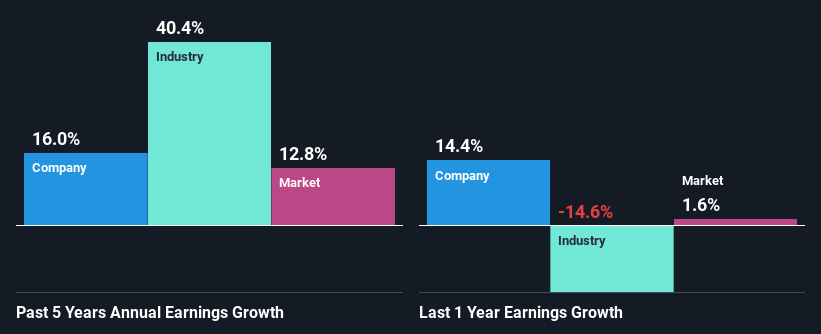- United States
- /
- Oil and Gas
- /
- NYSE:TPL
Is Texas Pacific Land Corporation's (NYSE:TPL) Stock's Recent Performance Being Led By Its Attractive Financial Prospects?

Texas Pacific Land (NYSE:TPL) has had a great run on the share market with its stock up by a significant 22% over the last three months. Given the company's impressive performance, we decided to study its financial indicators more closely as a company's financial health over the long-term usually dictates market outcomes. Specifically, we decided to study Texas Pacific Land's ROE in this article.
Return on equity or ROE is an important factor to be considered by a shareholder because it tells them how effectively their capital is being reinvested. Simply put, it is used to assess the profitability of a company in relation to its equity capital.
View our latest analysis for Texas Pacific Land
How Is ROE Calculated?
Return on equity can be calculated by using the formula:
Return on Equity = Net Profit (from continuing operations) ÷ Shareholders' Equity
So, based on the above formula, the ROE for Texas Pacific Land is:
43% = US$449m ÷ US$1.1b (Based on the trailing twelve months to September 2024).
The 'return' is the profit over the last twelve months. That means that for every $1 worth of shareholders' equity, the company generated $0.43 in profit.
What Is The Relationship Between ROE And Earnings Growth?
We have already established that ROE serves as an efficient profit-generating gauge for a company's future earnings. Based on how much of its profits the company chooses to reinvest or "retain", we are then able to evaluate a company's future ability to generate profits. Generally speaking, other things being equal, firms with a high return on equity and profit retention, have a higher growth rate than firms that don’t share these attributes.
Texas Pacific Land's Earnings Growth And 43% ROE
First thing first, we like that Texas Pacific Land has an impressive ROE. Second, a comparison with the average ROE reported by the industry of 15% also doesn't go unnoticed by us. This likely paved the way for the modest 16% net income growth seen by Texas Pacific Land over the past five years.
As a next step, we compared Texas Pacific Land's net income growth with the industry and were disappointed to see that the company's growth is lower than the industry average growth of 40% in the same period.

Earnings growth is a huge factor in stock valuation. It’s important for an investor to know whether the market has priced in the company's expected earnings growth (or decline). Doing so will help them establish if the stock's future looks promising or ominous. Is Texas Pacific Land fairly valued compared to other companies? These 3 valuation measures might help you decide.
Is Texas Pacific Land Using Its Retained Earnings Effectively?
Texas Pacific Land's three-year median payout ratio to shareholders is 23% (implying that it retains 77% of its income), which is on the lower side, so it seems like the management is reinvesting profits heavily to grow its business.
Besides, Texas Pacific Land has been paying dividends for at least ten years or more. This shows that the company is committed to sharing profits with its shareholders.
Conclusion
In total, we are pretty happy with Texas Pacific Land's performance. In particular, it's great to see that the company is investing heavily into its business and along with a high rate of return, that has resulted in a respectable growth in its earnings. If the company continues to grow its earnings the way it has, that could have a positive impact on its share price given how earnings per share influence long-term share prices. Remember, the price of a stock is also dependent on the perceived risk. Therefore investors must keep themselves informed about the risks involved before investing in any company. You can see the 1 risk we have identified for Texas Pacific Land by visiting our risks dashboard for free on our platform here.
Valuation is complex, but we're here to simplify it.
Discover if Texas Pacific Land might be undervalued or overvalued with our detailed analysis, featuring fair value estimates, potential risks, dividends, insider trades, and its financial condition.
Access Free AnalysisHave feedback on this article? Concerned about the content? Get in touch with us directly. Alternatively, email editorial-team (at) simplywallst.com.
This article by Simply Wall St is general in nature. We provide commentary based on historical data and analyst forecasts only using an unbiased methodology and our articles are not intended to be financial advice. It does not constitute a recommendation to buy or sell any stock, and does not take account of your objectives, or your financial situation. We aim to bring you long-term focused analysis driven by fundamental data. Note that our analysis may not factor in the latest price-sensitive company announcements or qualitative material. Simply Wall St has no position in any stocks mentioned.
About NYSE:TPL
Texas Pacific Land
Engages in the land and resource management, and water services and operations businesses.
Flawless balance sheet with acceptable track record.
Similar Companies
Market Insights
Community Narratives



